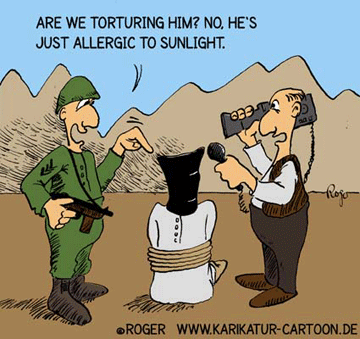
Interrogation Results Prompt Scrutiny Of Methods
by Dina Temple-Raston, NPR, Morning Edition, April 30, 2009
This is a story about two interrogation programs — one run by the U.S. military, the other run by the CIA. The military program was focused on getting important al-Qaida suspects in Iraq to talk. The CIA operation zeroed in on important al-Qaida suspects from around the world. Both programs had similar goals, but they operated under very difficult rules.
Earlier this month, former CIA Director Michael Hayden was on Fox News defending the CIA’s enhanced interrogation program.
“The use of these techniques against these terrorists made us safer,” he said emphatically. “It really did work.” As Hayden and others see it, the U.S. had to use tough techniques — some called it torture — to battle al-Qaida.
Matthew Alexander is an advocate of a different kind of interrogation — one that builds rapport, like the kind of technique you see on television cop shows. Alexander was a military interrogator in Iraq and doesn’t see the need for rough questioning.
“One of my best techniques for building rapport was to bring into the interrogation booth a copy, my copy, of the Koran and to recite a verse out of it or to ask questions about Islam,” he said.
It is important to know that Matthew Alexander wasn’t just any run-of-the-mill military interrogator. He was in charge of an interrogation team working on one of the most important counterterrorism operations of the war: the hunt for Abu Musab al-Zarqawi, the man in charge of al-Qaida in Iraq.
Learning From Challenges
Alexander and his team arrived in Iraq in March 2006 — well after the abuses at Abu Ghraib forced the military to reform its interrogation process. By the time Alexander’s team was on the ground, a military task force had been searching for Zarqawi for three years. But it took Alexander’s team just two months of questioning detainees to get one of them to reveal the location of Zarqawi’s safe house. Based on that information, the al-Qaida leader was killed in a military operation in June 2006.
“I know on the chase to Zarqawi we had several people during that chase who didn’t talk,” Alexander says. “But that was OK. We used the opportunities with detainees we couldn’t convince to cooperate to become better interrogators. And it was those skills we developed in those interrogations that allowed us to break the detainees who led us to Zarqawi.”
Alexander’s experience in Iraq is particularly instructive in the context of the current debate over whether harsh interrogation techniques work. That’s because Alexander and his team followed international standards for questioning and didn’t use any of the rough techniques the CIA adopted. And yet, without waterboarding or stress positions, Alexander says, he not only helped track down al-Qaida’s top man in Iraq but also managed to give the military better information.
“When you use coercion, a detainee might tell you the location of a house, but if you use cooperation they will tell you if the house is booby-trapped, and that’s a very important difference,” says Alexander. He says his success in Iraq proves that torture isn’t necessary to break a terrorist.
Philip Zelikow, a senior counselor to former Secretary of State Condoleezza Rice, agrees.
“Against very dedicated, very dangerous Islamist terrorists in Iraq in a raging war, we did not need to adopt the extreme interrogation methods that the CIA was using in the program it designed in 2002 and 2003,” he says.
Zelikow says the comparison of the two programs — one in Iraq and one by the CIA — allows one to judge whether harsh techniques were necessary. “Since the alternatives are effective and don’t have all these downsides, including all the moral and legal issues that come with them,” he says, “it seems like a very clear choice.”
Even if Hayden is right about the information the U.S. got from its interrogations, Zelikow says, it came at too high a cost.